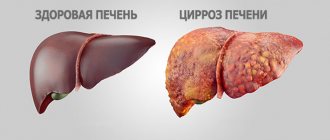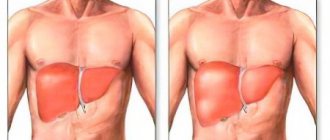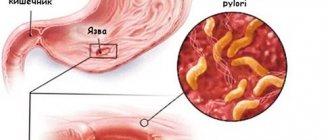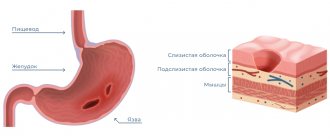The liver is the “laboratory” of the human body.
Complex reactions of splitting and neutralizing compounds coming from inside and outside take place in this gland. Constant toxic or infectious exposure leads to a malfunction of the organ and the gradual destruction of its structure. Healthy tissue is gradually displaced and the gland ceases to function normally. Liver cirrhosis is a chronic disease in which hepatocytes die and the affected areas of parenchyma are replaced by connective tissue. The surface becomes scarred and wrinkled. The changes are irreversible, especially in the last phase.
Treatment of liver cirrhosis in the early stages can stop the damage and prolong a person’s life for decades. At the same time, the liver remains active, which allows you to live a full life. Delaying contact with a doctor is fraught with serious irreversible consequences. How does pathology develop? Let's take a closer look.
If you need emergency help, contact Alco-Center
Call the hotline +7 (495) 773-03-43 and our doctors will provide emergency care for intoxication of the body with breakdown products of alcohol and narcotic substances.
from 3,200 rub.
Withdrawal from binge drinking
Emergency body detoxification procedure
from 4,000 rub.
Coding
Urgent blocking of cravings for alcoholic beverages
from 68,000 rub.
Rehabilitation
Comprehensive rehabilitation giving 100% results
Life expectancy of people with cirrhosis
More than 60% of people suffering from alcoholism acquire hepatobiliary pathology. 40% of them have cirrhosis. Statistics show an accelerated death rate in the absence of proper treatment and complete abstinence from alcohol in 99% of cases.
By undergoing treatment at the Resident-ReNa clinic, receiving therapy and following recommendations for rehabilitation and healthy behavior patterns, life can be extended in 90% of patients. If you take strong drinks after treatment, the disease actively progresses.
If treatment is not timely, a severe stage of the disease develops - hepatocellular carcinoma. Oncological pathology is incurable even if you give up alcohol and inevitably leads to death.
Causes of liver cirrhosis
It has been scientifically proven that regular consumption of alcohol over several years (10 or more) causes 60-70% of diagnosed cases of liver cirrhosis. Fibrosis originates from progressive alcoholic hepatosis. It is not without reason that those suffering from alcoholism are at risk of developing cirrhosis.
The prerequisites for the pathological process and the development of liver cirrhosis include:
- Chronic viral hepatitis C, B, D, G. More aggressive - type C. Virus carriage may not manifest itself for a long time, which is why in 97% it leads to massive death of hepatocytes.
- Autoimmune aggression provoked by a disorder in the immune system. Appears against the background of exposure to a virus or occurs independently.
- A parasitic infection that lasts for a considerable period of time.
- Long-term use of hepatotoxic drugs.
- The influence of toxic elements - work in hazardous industries, with reagents, chemicals.
- Development of bile duct obstruction.
- Chronic diseases of the heart and blood vessels cause venous stagnation and the formation of foci of necrosis.
The disease is asymptomatic and people are unaware of the existing threat. Progression is accelerated by a combination of several damaging factors. For example, alcohol addiction together with hepatitis C will quickly lead to a complicated course. Knowing the first signs and thinking about liver treatment is important. And yet, cirrhosis of the liver is not a death sentence and this disease is treatable and preventable.
general description
Liver cirrhosis is a chronic liver disease characterized by the replacement of parenchymal liver tissue with connective tissue (fibrosis), disruption of all functions, leading to death due to the irreversibility of the process itself.
The disease is widespread throughout the globe. According to statistics, the incidence of liver cirrhosis is steadily increasing. About 250-400 thousand deaths are recorded every year. And the tendency towards an increase in incidence is that the disease itself is asymptomatic.
The disease develops in all age groups, but more often in people of working age from 35-50 years (the ratio of men to women is 4 to 1).
Symptoms of liver cirrhosis
According to statistics, up to 80% of people who fall ill do not experience any significant changes in their health. A decrease in detoxification function provokes weakness, muscle pain and heaviness on the right side, under the lower rib after fried and fatty foods.
Undamaged cells are able to compensate for the work of dead cells up to a certain point. This condition lasts up to several years. Some patients experience dyspeptic disorders after drinking alcohol, even in small doses. Possible nausea, vomiting, pain in the epigastrium, flatulence, diarrhea. Once the symptoms are eliminated, everything stops.
Doctors distinguish three stages of liver cirrhosis with characteristic signs:
Compensated
- moderate pain in the right hypochondrium;
- feeling of bitterness in the mouth;
- disturbance of sleep and concentration;
- external phenomena - spider veins on the skin in the upper part of the body.
Subcompensated
- an increase in neurological symptoms - drowsiness, forgetfulness, handwriting changes, fingers trembling;
- skin manifestations - spider veins in the shoulder girdle area, itching, redness of the palms, pale nails, crimson tongue;
- baldness of the armpits and pubis;
- passing episodes of water retention, flatulence, diarrhea;
- increased bleeding;
- hormonal disorders - gynecomastia in men, menstrual irregularities in women.
Decompensated
- weight loss and loss of appetite;
- osteoporosis;
- muscle weakness;
- ascites that cannot be cured;
- darkening of urine and discoloration of feces;
- yellowing of the skin and sclera;
- increased body temperature;
- hepatic encephalopathy - dizziness, heaviness in the head, confusion, possible coma;
- the addition of infection and the occurrence of pneumonia, sepsis;
- varicose veins of the digestive tract.
External signs of liver cirrhosis - “stars, red palms, a bright shade of the tongue - are associated with an excess of female sex hormones. An imbalance that occurs during the breakdown of hormones is to blame for this. Therefore, they accumulate and expand the capillaries.
When palpated in the area of the right hypochondrium, in 30% of patients, an uneven, knotty surface of the deformed gland is revealed. In 70% it is enlarged, and in 50% an enlarged spleen is added. At the stage of decompensation, a decrease in size below normal is noted. This is due to the greater coverage of fibrosis.
There are active and inactive forms. The first is characterized by slow growth of connective fibers, which lasts up to several years. Sometimes - decades. The second is characterized by progression. In the presence of provoking factors - drinking alcohol, smoking, etc., it quickly passes into the decompensated phase. Concomitant HIV infection also contributes to rapid progression.
Special methods are used to detect dangerous violations.
Stages of the disease: severity
Each stage of the disease is characterized by distinctive symptoms. The stage will also be determined by the person’s general condition and the necessary therapy.
| Stage | First (compensated) | Second (subcompensated) | Third (terminal) | Fourth |
| Peculiarities | The initial stage is characterized by a practically asymptomatic course. If the disease can be identified during this period, then effective therapy is possible with the help of medications. A person may feel absolutely healthy (rare pain in the right side is acceptable), but changes are already visible in a biochemical blood test. | This stage is characterized by a pronounced decrease in the functioning of the organ. During this period, the first signs of the disease are observed: decreased performance and deterioration in general well-being, nausea and vomiting. With properly selected treatment, it is possible to transfer the patient from the second stage to the first. | This stage is characterized by a rapid increase in symptoms of the disease and further development of liver failure. There are chances of feeling better, but they are small. The sick person must be in a hospital: metabolic disorders are observed, ascites often develops. | The last stage of the disease has a very unfavorable prognosis: without a liver transplant, it is impossible to stop the progression of cirrhosis - everything ends in death. The pain is so severe that the person has to constantly take strong painkillers. |
The cause of death can be very serious complications of cirrhosis, including: liver cancer, peritonitis, pneumonia, hepatic coma.
Diagnosis of liver cirrhosis
Liver cirrhosis is often discovered unexpectedly during examination for another reason. Specific diagnostics include assessment of complaints, examination of the skin and oral mucosa. In addition, laboratory techniques are used.
The main indicator is a biochemical blood test. An increase in the values of ALT and AST, bilirubin and globulin fractions, as well as a decrease in the number of albumin fractions indicates persistent dysfunction. Deviations in creatinine and urea indicate abnormalities in kidney function.
General expanded shows reduced hemoglobin, elevated leukocyte levels and decreased platelets.
Specific markers of viral hepatitis using qualitative PCR.
Ammonia test. It does not break down and accumulates, causing intoxication.
Detection of oncology - alpha-fetoprotein (AFP) test.
Determining the concentration of immunoglobulins A and G, as well as T-lymphocytes, reveals autoimmune aggression towards its own components.
Fecal occult blood testing reveals signs of bleeding in the gastrointestinal tract.
In addition to laboratory tests, accurate information is obtained through hardware testing.
- MRI and computed tomography can detect necrosis at the beginning of development. They detect tumor neoplasms and fibrotic foci.
- Ultrasound detects fibrous areas, determines dimensions and changes in structure. Examination of the abdominal organs, ultrasound of the abdominal cavity, shows an enlargement of the gland - hepatomegaly and spleen - splenomegaly, the size of the portal vein. The conclusion is used to select the correct therapeutic tactics.
- Elastometry determines the degree of fibrosis.
- Biopsy - collection of biomaterial by puncture is done in a hospital. An informative method allows you to determine the type, root cause and degree of damage.
- FEGDS reveals varicose veins in the stomach and esophagus and the presence of nodes.
- Scintigraphy is a radionuclide examination that helps evaluate functioning. A chemical radiopharmaceutical compound is administered. By its further distribution in the body, the ability to capture and neutralize toxins is judged. In such a situation, this function is reduced. The settling of the element in the bones of the spine and pelvis indicates a critical situation.
In the compensated phase, destruction can be stopped. It will not be possible to recover completely. It is important to detect changes in time and take action. To do this, you need to consult a specialist - a hepatologist or gastroenterologist.
Diagnosis by physical examination
The second stage of diagnosis is a physical examination of the patient, based on the results of which the specialist prescribes additional types of laboratory and hardware examinations. Changes in the liver at the early stage of cirrhosis are mild, so manifestations of the disease may be absent. At later stages of the development of cirrhosis, symptoms manifest themselves in full.
When visually examining the patient, the doctor pays attention to the presence of the following signs:
- yellowing of the sclera of the eyes and skin;
- muscle tissue atrophy;
- weight loss;
- formation of spider veins;
- expansion of veins in the abdominal area;
- swelling of the lower extremities;
- abdominal enlargement;
- hemorrhagic skin rashes;
- dull sound when tapping the abdomen;
- inguinal and umbilical hernias.
Palpation during examination can detect changes in the size of the liver and spleen, which indicate the development of cirrhosis. During the procedure, the specialist determines the degree of compaction of the organ and the presence of irregularities on its surface. If an illness is suspected, the patient is referred for laboratory tests.
Treatment of liver cirrhosis
The main condition for successful therapy is the elimination of the causes that led to the pathological condition. This includes giving up alcohol, stopping hepatotoxic drugs, compensating for heart failure, eliminating infection, and following a diet.
If you start the fight when there are no obvious manifestations, you can achieve lasting improvement. Tactics are selected by the doctor individually. But there are unifying principles.
Nutrition and daily routine
For the fastest recovery, you need to eat right. Diet No.5 is prescribed. It excludes fried, spicy and smoked foods. Fatty foods - meat, fish and animal fats in any form remain prohibited. Low-fat protein foods are limited. Industrial canned food, offal and meat, fish, and mushroom broths will have to be put aside. Dishes made from legumes and high in spices are not allowed.
The doctor will recommend a decoction of rose hips or dried fruits to normalize digestion and reduce swelling. Salt is also limited. You need to eat up to 6 times a day in small portions, preferably at the same time. The daily routine includes naps and walks in the fresh air. Physical activity is limited. Lifting heavy objects and walking long distances is avoided.
Medicines
Therapy is prescribed by a specialist. Self-medication will lead to delaying time and worsening the situation. The doctor will draw up a suitable rehabilitation program, taking into account the information received. The treatment complex includes:
- Hepatoprotectors restore damaged hepatocytes and protect against damage. Preparations of ursodeoxycholic acid, essential phospholipids, and milk thistle are mainly prescribed. They stimulate the secretion of bile and reduce intoxication. This improves well-being, eliminates cramps and nausea, and improves digestion.
- Diuretics reduce swelling and remove fluid accumulated inside the peritoneum. If there is no effect, then the contents are pumped out through a puncture in the abdominal wall.
- Antibiotics are prescribed to prevent peritonitis and bacterial infection.
- Beta blockers - Atenolol, Propranolol, reduce pressure in the portal vein.
- Containing lactuose - Duphalac, Normaze, Prelaxan. Neutralizes amino acids in the intestines that cause encephalopathy.
- Complexes of vitamins B, A, C, E, P, cocarboxylase and alpha-lipoic acid improve metabolism and exhibit an antioxidant effect.
- Reducing ammonia levels - Ornilatex, Hepa-Merz, zinc preparations.
- Lipotropic agents - Heptral, Lecithin, Betargin stimulate lipid metabolism, reduce “bad” cholesterol, stimulate lipid oxidation and prevent their deposition in the cell.
- Enzymes – Mezim, Pancreatin, Creon, Micrasim, etc.
- Plant-based soothing tablets – Novopassit, Persen, Valerian and Motherwort extract. Tinctures are contraindicated here, but water infusions of medicinal herbs will be beneficial. But, before use, you will need to consult a doctor.
The result depends on the psychological mood and the efforts made. It is necessary to strictly adhere to the recommendations and medication regimen, and monitor body weight daily.
Surgical
Surgery is performed for varicose veins of the esophagus. During the manipulation, vascular anastomoses are performed and the affected areas are removed.
If the results of MRI and CT scans reveal oncological tumors, they are removed surgically. But, intervention is allowed only at the compensation stage.
Transplantation
In advanced situations, with severe damage, a liver transplant is performed. Sometimes, this is the only chance to save the patient. Unfortunately, the operation does not always end successfully.
According to the Russian Transplantation Center, Research Institute of Emergency Medicine named after. Sklifosovsky, survival rate in the postoperative year is 91%, in the next year - up to 82%. The disadvantages of this method include a large list of contraindications and high cost.
Additional types of examinations
Diagnostic research methods are not limited to physical examination and laboratory tests. If there are characteristic changes in the biochemical parameters of the blood, the patient is referred for instrumental examination. Hardware visualization of the liver, bile ducts and blood vessels provides comprehensive information about the condition of the organ and the pathological processes occurring in it.
Laparoscopy
Laparoscopy is a minimally invasive operation that is performed to confirm CP. The differential diagnosis of liver cirrhosis practically does not encounter any difficulties. During the examination, it is differentiated from echinococcosis, cancer and syphilis, in which changes similar to cirrhotic ones occur in the digestive gland.
During laparoscopic diagnosis, a specialist sees the surface of the affected organ and evaluates the visual picture. With large-nodular (macronodular) cirrhosis, large irregularly shaped nodes are found, the diameter of which is 3 or more millimeters. If the surface of the liver is furrowed with small nodules, micronodular cirrhosis is diagnosed, and if large nodular inclusions are found between them, mixed cirrhosis is diagnosed.
Ultrasound
Ultrasound is one of the most informative methods of hardware examination, the results of which can make a final diagnosis, but only with the development of a decompensated form of the disease. At the compensation stage, ultrasound will show a slight increase in the digestive gland, but its surface will be uniform and smooth. With subcompensated and decompensated CP, the image will show nodular formations, tuberosity and a heterogeneous structure of the organ.
Determination of unevenness of the liver lobes most often indicates rapid progression of the disease. As a rule, it is the left side of the liver that greatly increases in size. As symptoms of liver failure increase, the shape and size of the organ change. In the last stages of cirrhosis, it is completely covered with fibrous adhesions and greatly decreases in size.
Biopsy
Biopsy is the excision of a small piece of parenchymal tissue, which is performed for the purpose of histological analysis. The presence of cirrhotic changes in the liver is indicated by:
- dense nodular formations surrounded by connective tissue;
- uneven expansion of bile canaliculi;
- swelling of liver cells and changes in their shape;
- dilation of venous vessels and necrosis of hepatocytes;
- weak expression of the border between connective and parenchymal tissue (active cirrhosis);
- a clear boundary between the parenchyma and fibrous adhesions (inactive cirrhosis).
Biopsy is the most accurate diagnostic method, which gives an idea of the stage of development of the disease and the causes of its occurrence.
Complications of liver cirrhosis
They are the result of carelessness or lack of awareness of the seriousness of the consequences. Severe complications cannot be cured and cause death. These include:
Ascites is an accumulation of liquid substance in the peritoneum. The abdomen increases, which is noticeable even in a lying position. There is weight gain and swelling of the legs. Swelling does not go away after rest and makes movement difficult.
Bacterial peritonitis occurs when fluid in the abdominal cavity becomes infected. Body temperature rises - up to 40C, severe pain and malaise appear. In the absence of emergency assistance, death occurs.
Hepatic encephalopathy is a neurological symptom complex. Headache, dizziness, and unsteady gait are observed. Often progresses into a coma.
Acute renal failure due to dysfunction of the hepatobiliary system. In the absence of timely resuscitation, it ends in death.
Portal hypertension is accompanied by varicose veins of the gastrointestinal tract. Because of this, bleeding begins, during which the pressure drops, and vomiting with bloody elements appears. The condition often ends in death. Resuscitation does not always help save the patient.
Hepatocellular carcinoma is the formation of a cancerous tumor. Occurs when the disease lasts for a long time. Provoking factors are considered to be heredity and bad habits - smoking, alcoholism. In case of single tumors and the absence of metastases, it is removed surgically. In case of extensive degeneration, transplantation will help solve the problem.
The likelihood of complications of liver cirrhosis increases significantly with an inadequate approach or late detection of problems. To protect yourself, you need to undergo a preventive examination once a year, take general and biochemical tests, and do an ultrasound scan of the body. At the slightest suspicion, it is better to consult a doctor.
To prevent liver cirrhosis, play sports or engage in other adequate physical activities. Classes should be regular, preferably in the fresh air. This will help avoid stagnation. The psycho-emotional background is of great importance. Stress causes spasm of internal organs, which affects their functioning. It is better to avoid negative emotions as much as possible.
You should not ignore problems with bile discharge and excess weight. It is important to follow healthy eating rules. Doctors advise keeping a food diary. More movement, less negative emotions - the rule for restoring strength. An active lifestyle and giving up bad habits - drinking alcohol and smoking - will help avoid serious health misunderstandings and eliminate the causes of liver cirrhosis.
Author of the article: Yakovlev Evgeniy Anatolyevich
Narcologist, Candidate of Medical Sciences.
Diagnostics and treatment measures
It is very difficult to identify pathology at the initial stage of development. The diagnosis can be made using ultrasound, x-ray and radionuclide examination. In order to give an accurate assessment of the condition of the liver, computed tomography is used. However, the most effective diagnostic method is a puncture biopsy procedure, which makes it possible to examine organ tissue and determine dysfunction.
When liver cirrhosis is detected, therapeutic measures primarily involve reducing physical and mental stress. Also, the attending physician will definitely prescribe a special diet (table No. 5) and a set of therapeutic exercises. At the initial stage of development of the disease, no medications are used.








